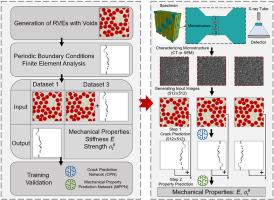A two-stage deep learning framework for predicting crack patterns and mechanical properties of unidirectional composites with void defects
IF 9.8
1区 材料科学
Q1 MATERIALS SCIENCE, COMPOSITES
引用次数: 0
Abstract
Void defects in unidirectional composites critically govern crack initiation and propagation, leading to substantial degradation of transverse mechanical properties. To accurately characterize the influence of void defects on composites, this study proposes a novel two-stage deep learning framework that integrates U-net for crack pattern predictions and convolutional neural network for predicting stiffness and strength of unidirectional composites with void defects. To improve accuracy of mechanical property prediction, the innovative feature-fusion mechanism utilizes both material microstructures and corresponding crack patterns generated by the crack prediction network as input features. For the training of deep learning framework, a comprehensive dataset, generated through micromechanical modeling, contains randomly distributed fibers, inter-fiber voids, matrix voids, and resin-rich areas. The proposed framework achieves high-precision predictions of crack patterns and mechanical properties while significantly reducing computational costs, demonstrating strong potential for applications in material design.

一种两阶段深度学习框架用于预测含空洞缺陷的单向复合材料的裂纹模式和力学性能
单向复合材料中的空洞缺陷对裂纹的萌生和扩展起着关键的控制作用,导致横向力学性能的严重退化。为了准确表征空洞缺陷对复合材料的影响,本研究提出了一种新的两阶段深度学习框架,该框架集成了用于裂纹模式预测的U-net和用于预测具有空洞缺陷的单向复合材料刚度和强度的卷积神经网络。为了提高力学性能预测的准确性,创新的特征融合机制将材料的微观组织和裂纹预测网络生成的相应裂纹模式作为输入特征。对于深度学习框架的训练,通过微力学建模生成的综合数据集包含随机分布的纤维、纤维间空隙、矩阵空隙和富含树脂的区域。该框架实现了裂纹模式和力学性能的高精度预测,同时显著降低了计算成本,在材料设计中显示出强大的应用潜力。
本文章由计算机程序翻译,如有差异,请以英文原文为准。
求助全文
约1分钟内获得全文
求助全文
来源期刊

Composites Science and Technology
工程技术-材料科学:复合
CiteScore
16.20
自引率
9.90%
发文量
611
审稿时长
33 days
期刊介绍:
Composites Science and Technology publishes refereed original articles on the fundamental and applied science of engineering composites. The focus of this journal is on polymeric matrix composites with reinforcements/fillers ranging from nano- to macro-scale. CSTE encourages manuscripts reporting unique, innovative contributions to the physics, chemistry, materials science and applied mechanics aspects of advanced composites.
Besides traditional fiber reinforced composites, novel composites with significant potential for engineering applications are encouraged.
 求助内容:
求助内容: 应助结果提醒方式:
应助结果提醒方式:


